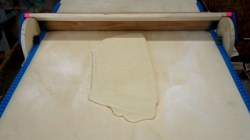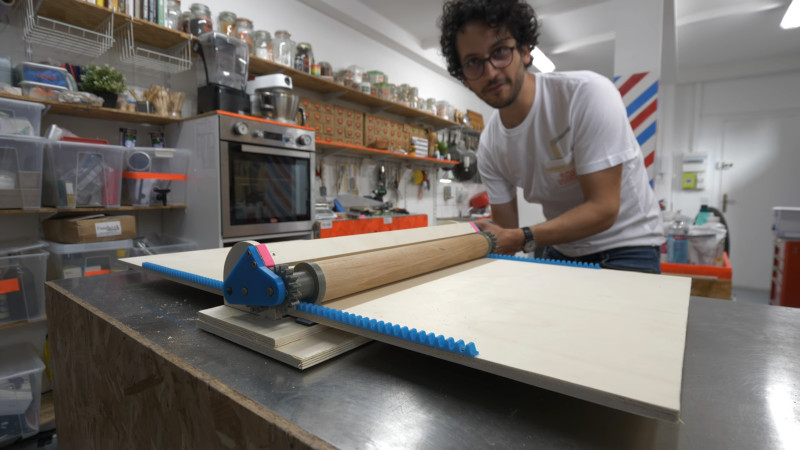Baking is a wonderful pastime, as much an art as a science. [Alex] pursues the craft with plenty of vigor, and had built his very own dough sheeter to assist in his work. Unfortunately, the design had several flaws, and came out of a recent move rather the worse for wear. Growing tired of having to deal with dough of inconsistent thickness, he went back to the drawing board to whip up a new version (Youtube link, embedded below).

The core of the machine is a moving platform combined with a rolling pin, that can be set to a desired height to roll the dough into a set thickness. This is key to baking top-notch croissants, which [Alex] takes very seriously. His initial model used a table leg for a rolling pin, fitted with a threaded rod down the centre. This had significant issues with both runout, and uneven diameter across its length. Additionally, its frame had not held up after a recent move, and [Alex] was keen to start again.
The new model starts with attention paid to the basic engineering issues. The table leg is replaced with a professional-grade rolling pin, fitted with 3D-printed gears that accurately align the axis of rotation to the centre of the pin. A rack and pinion drive is also added to move the dough platform. Finally, a locking pin system is used to set the desired height of the dough.
It’s a useful project for the keen baker, and one that leans heavily on additive manufacturing methods. Producing such a tool in the years before 3D printers would have required significant effort to produce the required gears and mating components, so it’s impressive to see how easily something like this can come together these days. A hacker mindset can always be handy for baking – don’t forget, you can improve your bread crusts with steam! Video after the break.
















My main thought: why is it so complicated? It seems like a table with raised rails at the edges that a rolling pin can run along would get the job done just as well and be so much simpler. For variable thickness you could slip some rings on the end of the ends of the roller to raise it.
If it were like you described he’d not get the views and interest he has got. His channel is pretty good actually, especially his troubles with pasta machines and getting consistent quality of work. This video though, is a poor example of his work.
If I remember the original video correctly, the reason why he’s got the moving platform and fixed roller is because that’s the way the professional machine he was copying did it. Why that machine had that configuration is unclear, but it could be as simple as mechanical advantage. Cold dough is really goddamn hard to compress, and you don’t want to be doing it by manually pressing down. That’s why pasta machines have two fixed rollers, after all.
My guess for why this uses a board instead of a second roller is that the dough is too fragile and layered to survive the movement and weird mixing forces you get in a pasta machine. Whenever you feed dough into one of those it balls up and mixes – good for pasta, bad for pastry.
So, long and short – the machine is probably complicated because it’s providing mechanical advantage, not just a depth guide.
The industrial machines we use for laminating dough do have 2 rollers and a belt on either side. The rollers spin faster than the belts to eliminate that bunching up and mixing.
Rolling the dough involves frequent changes to the rolling thickness, which his design allows for easily. Also, his design guarantees more even rolling.
Top tip: for consistent thickness buy a rolling pin with adjustable guide brushings (Joseph&Joseph or make your own). If you struggle to apply enough pressure just eat more croissants.
Don’t know if you are missing the point or making a joke, but if you actually look up “Dough Sheeter” and look at the professional version of this machine… most of them look exactly like Alex’s. Obviously it’s overkill for a home kitchen, but Alex regularly goes above and beyond what’s required for (or rational to even have in) a home kitchen.
If you try to laminate dough by hand you’ll know that it ain’t overkill.
The joy of humour not translating across the internet, funnily enough I spent many happy months developing high pressure extrusion systems and am painfully aware of the pressures and technical challenges involved in processing dough :-)
Can you tell us how many Newton’s of force are required to flatten a square inch of a standard ball of dough?
Speaking of overkill, he just did a video where he created a puff pastry with more than a million layers.
I was thinking of using a couple of strips of UHMW, with different thicknesses, but different thickness rings on the rolling pin ends would be easier to use.
Because the professional machine can start with a 4” thick ball of dough and gradually flatten it down to 1/4 inch.
Then it can flatten a thick layer of butter down to 1/4 inch.
Then put the butter on top of the dough, fold it over, flatten, and repeat.
All without unevenly compressing the dough.
That’s hard to do with a handheld rolling pin.
I think the gears are probably unnecessary – rubber rollers should be adequate. I’ve been thinking about something similar where I can attach it to my kitchen island butcher block. I was thinking about aluminum extrusions, so it works similar to a CNC Z-axis. Automating with an Arduino/Pi wouldn’t be too hard, either.
But without them how would you justify owning a plastic squirter?
Not food-safe though.
The dough should only be only in contact with the wood surfaces.
By the same metric neither is wood. Your ancestors used to eat off the dirt granted they had worms but “food safe” is an empty platitude.
The Romans used lead pipes and cookware. Ask Flint how well THAT works.
Food safe is a pretty bloody important concept, and if you think otherwise you don’t actually understand what’s in the materials around you. And the wood ISN’T food safe – it looks like hardware store plywood, so it’s full of nasty epoxies, never mind actual splinters to contaminate the pastry.
You’re like the people who use drain cleaner lye to make pretzels. They scoff at “food grade.” Lye is Lye! And look, it’s 100% Lye. Except the manufacturing process for drain cleaner uses mercury, and the food grade stuff doesn’t, so all their pretzels are slightly contaminated with heavy metals – and if there was a manufacturing error, maybe a lot contaminated.
Sigh. It’s 3D printed plastic and plywood. I’m pretty sure sealing with Food Safe mineral oil would be easy.
That looks exactly like the mechanism in a “proof press” used in letterpress printing. Build it 20x stiffer and you could use it for either job!
Do you guys use spyware on your site? This has gotta be the 5th or 6th youtube video Ive watched and magically read an article about the next day. Its uncanny.
“sfogliatrice” on Amazon.
you welcome.
Croissants are Austrian NOT French -> https://en.wikipedia.org/wiki/Croissant
And now that we’re on it Fries are not a French nor a Belgium invention. Belgium didn’t exist back than so they’re Dutch Fries.
Don’t blame the French; they call the entire category of Croissant-like pastry “viennoiserie.”
Thank you for sharing your 3-D model. Enjoyed watching and learning.